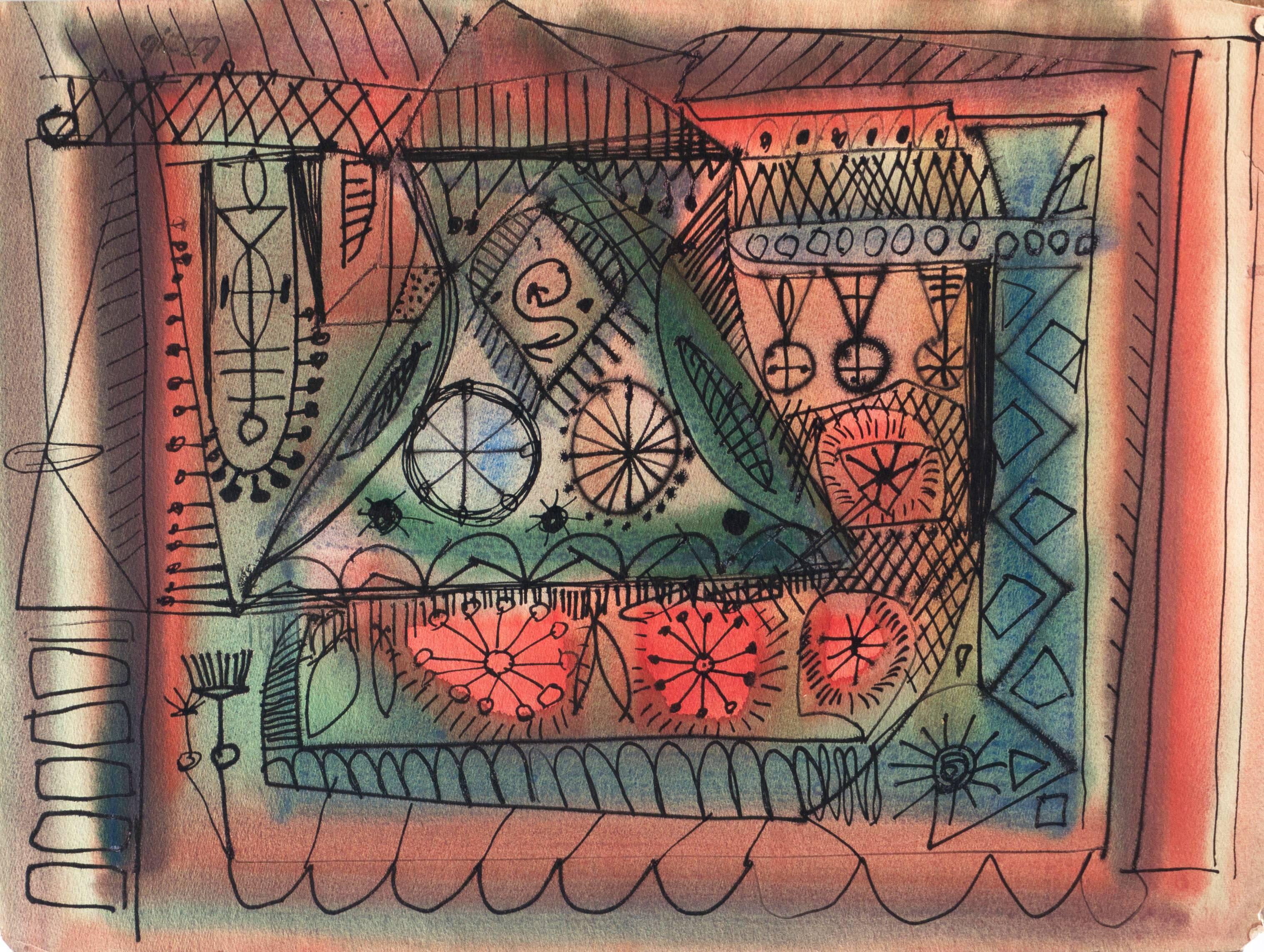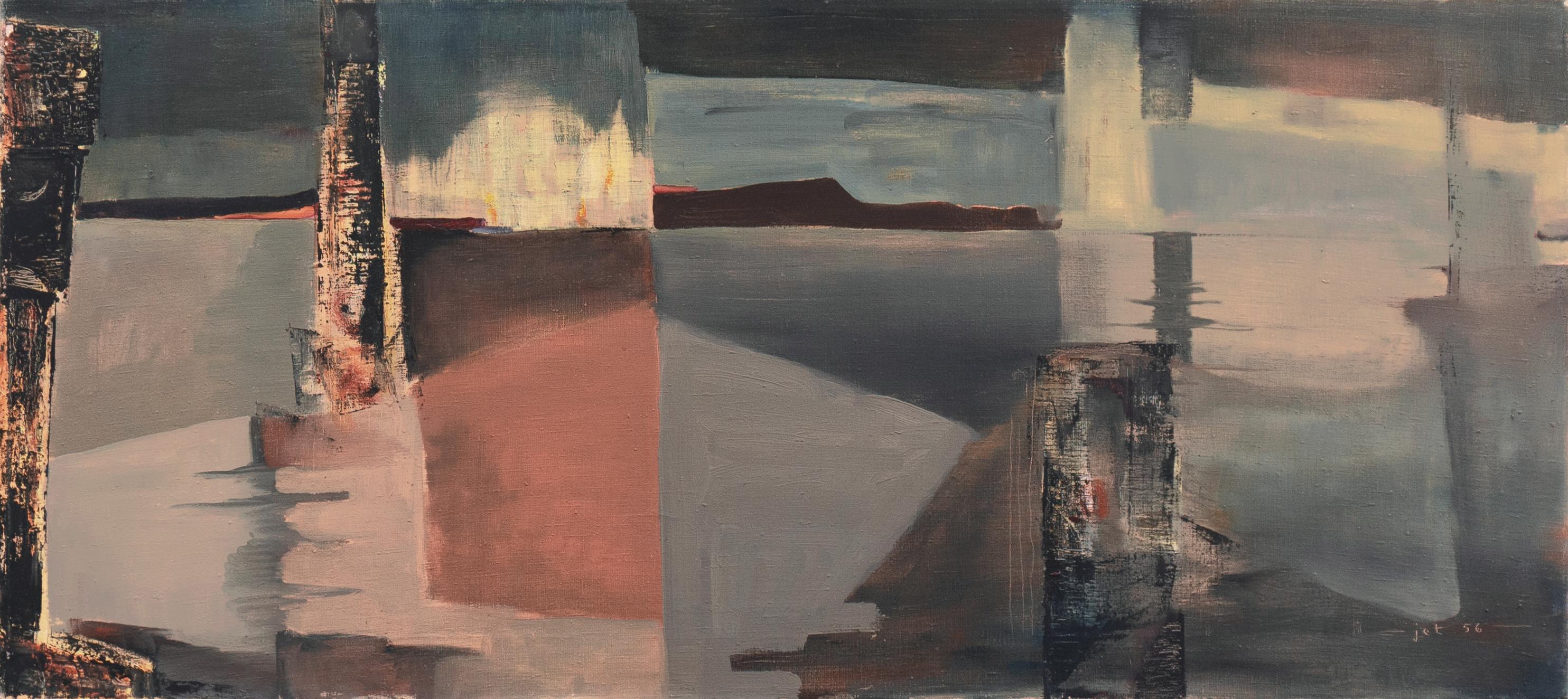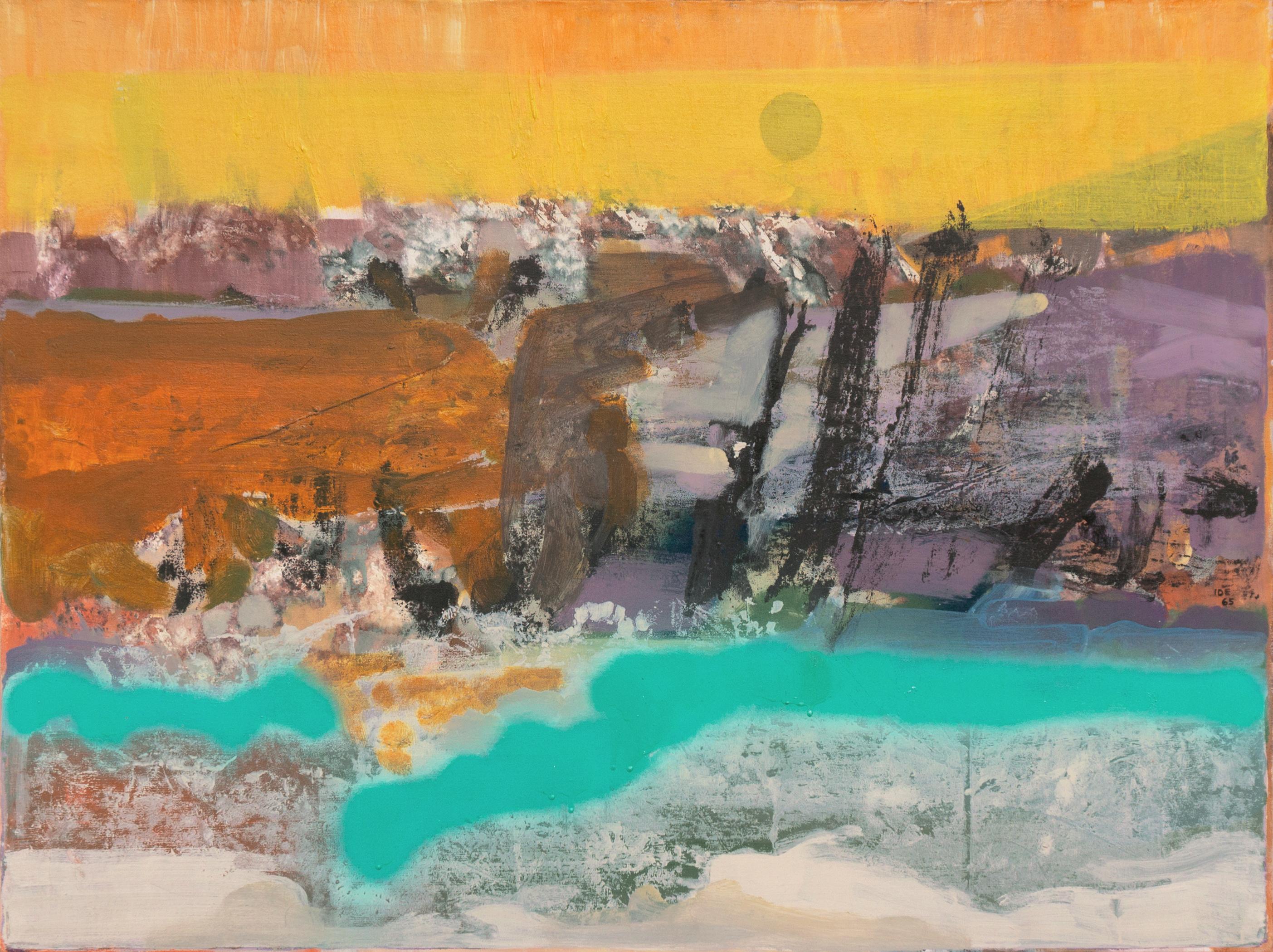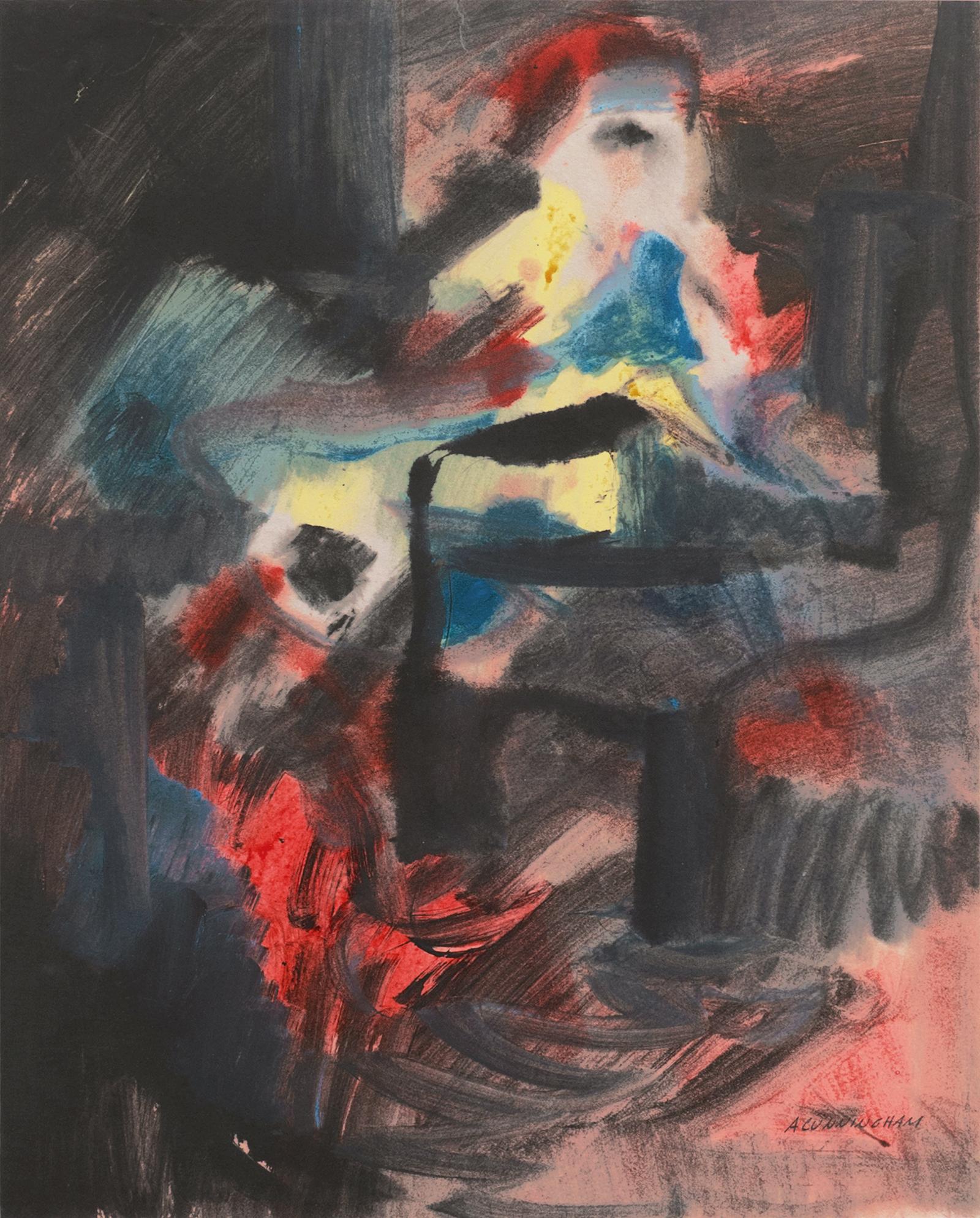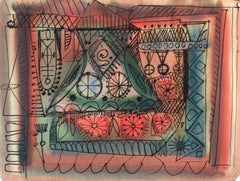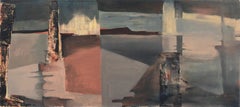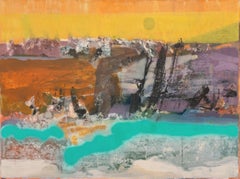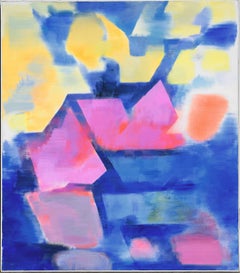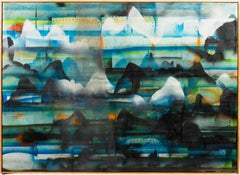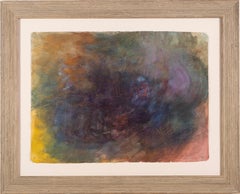Items Similar to 'Evening Landscape' Bay Area Abstraction, San Francisco Museum of Fine Arts, CWS
Want more images or videos?
Request additional images or videos from the seller
1 of 12
Robert George Gilberg'Evening Landscape' Bay Area Abstraction, San Francisco Museum of Fine Arts, CWSCirca 1955
Circa 1955
$3,600
£2,672.81
€3,114.56
CA$4,997.96
A$5,590.54
CHF 2,909.35
MX$68,821.40
NOK 37,012.93
SEK 34,725.42
DKK 23,237.70
Shipping
Retrieving quote...The 1stDibs Promise:
Authenticity Guarantee,
Money-Back Guarantee,
24-Hour Cancellation
About the Item
Signed lower right, 'Gilberg' for Robert George Gilberg (American, 1911-1970) and painted circa 1965.
Born in Oakland, Robert George Gilberg first studied at the Oakland Art Center during the 1930s. Following service during WWII, he settled in Nevada City, California where he lived and painted until shortly before his death in San Francisco. Gilberg exhibited widely and with success and was the recipient of numerous medals, prizes and juried awards, including at the San Francisco Museum of Fine Arts, (1941, 1942, solo); the California Watercolor Society, (1946-53); the Army Art Exhibit, (1945, 1st prize) and the California State Fair (1957) among others.
In his foreword to the catalog of Robert Gilberg's 1971 Memorial Exhibition, Wayne Thiebaud asked: "How in the world did he build such worlds?" Answering his own question, though only partially, Thiebaud said: "Good paintings insist on a curious magic... of turning the simple into the grand."
Although not much given to explaining his own work, Gilberg has written:
"Art springs from the urge to communicate.
It is not always the absolute portrayal of existing fact.
We all have ideas to convey,
We all recognize beauty,
We all respond to nature's moods.
The color of winter is drab;
The trees of winter are naked;
The color of spring is brilliant;
The trees of spring are clothed with leafiness.
Through art, we make evident our profoundest responses"
- Robert Gilberg, 1948
Paper laid down on archival board. Board dimensions: 17.5 x 23.5 inches
- Creator:Robert George Gilberg (1911-1970, American)
- Creation Year:Circa 1955
- Dimensions:Height: 17 in (43.18 cm)Width: 22.75 in (57.79 cm)Depth: 0.13 in (3.31 mm)
- Medium:
- Movement & Style:
- Period:
- Condition:paper laid down on 100% cotton archival rag-board; minor restoration, minor creasing, shows well; unframed.
- Gallery Location:Santa Cruz, CA
- Reference Number:1stDibs: LU3448065782
About the Seller
5.0
Platinum Seller
Premium sellers with a 4.7+ rating and 24-hour response times
Established in 1982
1stDibs seller since 2013
738 sales on 1stDibs
Typical response time: 1 hour
- ShippingRetrieving quote...Shipping from: Santa Cruz, CA
- Return Policy
Authenticity Guarantee
In the unlikely event there’s an issue with an item’s authenticity, contact us within 1 year for a full refund. DetailsMoney-Back Guarantee
If your item is not as described, is damaged in transit, or does not arrive, contact us within 7 days for a full refund. Details24-Hour Cancellation
You have a 24-hour grace period in which to reconsider your purchase, with no questions asked.Vetted Professional Sellers
Our world-class sellers must adhere to strict standards for service and quality, maintaining the integrity of our listings.Price-Match Guarantee
If you find that a seller listed the same item for a lower price elsewhere, we’ll match it.Trusted Global Delivery
Our best-in-class carrier network provides specialized shipping options worldwide, including custom delivery.More From This Seller
View All'Dynamic Abstract', California San Francisco Bay Area Modernism, Thiebaud
By Robert George Gilberg
Located in Santa Cruz, CA
A substantial, mid-century watercolor abstract comprising interrelated geometric and biomorphic elements in a palette of primary and secondary colors.
Signed upper left, 'Gilberg' ...
Category
1940s Abstract Abstract Drawings and Watercolors
Materials
Paper, Watercolor, Gouache, Pen
'View of San Francisco Bay', Bay Area Abstraction, Jack London, Modernist Oil
Located in Santa Cruz, CA
Initialed lower right, 'J.e.t.' for Jessie E. Thomason (American, 20th Century) and dated 1956. Exhibited: Jack London Art Festival, 1956.
Displayed in the original and period, paint...
Category
1950s Abstract Expressionist Abstract Paintings
Materials
Canvas, Oil
'Forms in Charcoal and Jade', San Francisco Bay Area Abstraction, SFMFA, CWS
By Robert George Gilberg
Located in Santa Cruz, CA
Signed lower right, 'Gilberg' for Robert George Gilberg (American, 1911-1970) and dated '58'.
Born in Oakland, Robert George Gilberg first studied at the Oakland Art Center during t...
Category
1950s Abstract Abstract Paintings
Materials
Encaustic, Gouache, Laid Paper
'Canyon River', San Francisco Bay Area Abstraction, Mid-Century, Maxwell Gallery
Located in Santa Cruz, CA
Signed center right, 'Ide' for Tom Ide (Canadian-American, 1919-1996) and dated 1965.
Exhibited: Maxwell Galleries, San Francisco, circa 1965.
Ide studied at the Art Institute of Chicago (1951-1955) and moved to San Francisco in 1960, where he became a notable exponent of Bay Area abstract expressionism. He exhibited with success including at Maxwell Galleries (1964 solo), where the present piece was exhibited. Tom Ide's work was included in the 2021 exhibit “East/West Abstraction: Asian American Artists...
Category
1960s Abstract Abstract Paintings
Materials
Canvas, Oil
'Abstract', Marin, Watercolor Artists of San Francisco, De Young Museum
Located in Santa Cruz, CA
Signed lower right, 'A. Cunningham' for Alfred A Cunningham (American, 20th century) and painted circa 1965.
Alfred Cunningham was active in Northern California from the 1950's thro...
Category
1960s Abstract Expressionist Abstract Drawings and Watercolors
Materials
Paper, Gouache
'Abstracted Landscape', Abstract, Mills College, Whitney Museum, CCAC, ASL
Located in Santa Cruz, CA
Signed lower right, 'Schoener' for Jason Schoener (American, 1919-1997) and painted circa 1970. Titled 'Choruscating Landscape' (labels, verso). Accompa...
Category
1970s Abstract Abstract Paintings
Materials
Paper, Gouache
You May Also Like
1980s Abstracted Bay Area Landscape -- Oakland to Tamalpais Views
By Erle Loran
Located in Soquel, CA
Gorgeous colors in this abstract of the sunrise on the bay by Erle Loran (American, 1905-1999), a modernist of urban and coastal views and geometric painting. Signed on verso. From a...
Category
1980s Abstract Geometric Abstract Paintings
Materials
Canvas, Acrylic
$4,160 Sale Price
20% Off
Large Mid Century California Modernist Sunset Landscape Framed Oil Painting
Located in Buffalo, NY
Antique American modernist abstract oil painting. Oil on canvas. Framed.
Category
1950s Modern Abstract Paintings
Materials
Canvas, Oil
$716 Sale Price
20% Off
Antique American Modernist Abstract Landscape Morris Shulman Signed Painting
By Morris M. Shulman
Located in Buffalo, NY
Vintage American modernist abstract Maine landscape painting. Watercolor and gouache on paper, circa 1960. Signed on verso. Image size, 30...
Category
1950s Abstract Landscape Paintings
Materials
Watercolor, Gouache
"Maine Landscape - Dusk II, " Oil on Canvas - Abstract Landscape Painting
Located in Houston, TX
Alfredo Gisholt's understanding of composition shines through in this abstract landscape in oil on canvas. Adhering to principles of design, the visual language employed is enough to...
Category
2010s Abstract Abstract Paintings
Materials
Canvas, Oil
Antique American Modernist Abstract Landscape Morris Shulman Signed Painting
By Morris M. Shulman
Located in Buffalo, NY
Vintage American modernist abstract Maine landscape painting. Watercolor and gouache on paper, circa 1960. Signed on verso. Image size, 30...
Category
1950s Abstract Landscape Paintings
Materials
Canvas, Oil
Vintage Abstract Composition - San Francisco School in Oil on Canvas
By Kristin Cohen
Located in Soquel, CA
Vintage Abstract Composition - San Francisco School in Oil on Canvas
A bold San Francisco School abstract expressionist painting by artist Kristin Cohen (American, b. 1963). Bright ...
Category
20th Century Abstract Expressionist Abstract Paintings
Materials
Canvas, Oil
More Ways To Browse
Robert Spring Watercolor
Wayne Thiebaud Landscapes
Impressionist Mountain Art
Blue Realist Paintings
Dior 2016
Salvador Dali Signed
Vintage African Photography
Harbor Painting
Unsigned Landscape Paintings
Unframed Antique Prints
African American Portrait
Framed Abstract Lithograph
Tokyo Modern Art
1920s Vintage Prints
Etching Library
Cuban Artists
Green And Blue Flower Art
Original Water Colour Paintings
